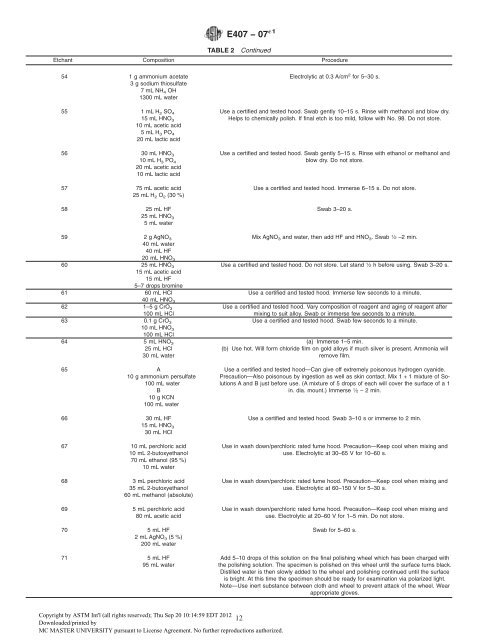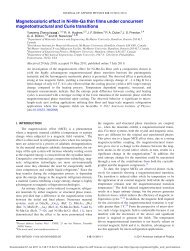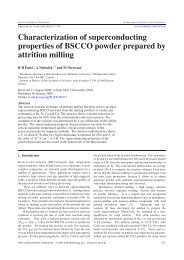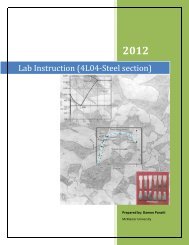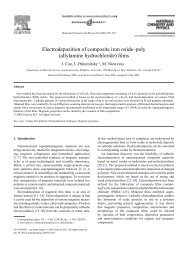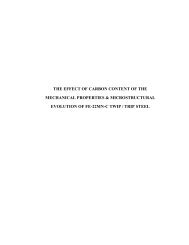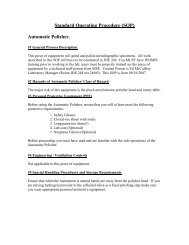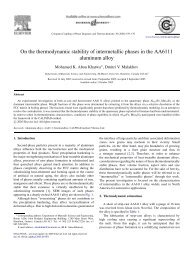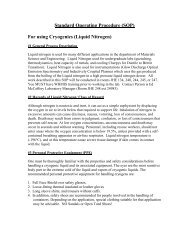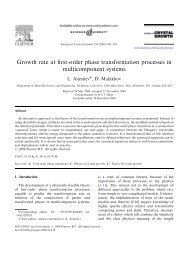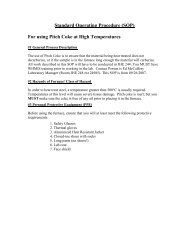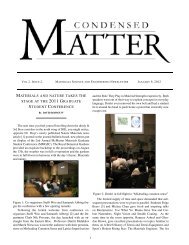E407-07 Microetching Metals and Alloys.pdf - McMaster Department ...
E407-07 Microetching Metals and Alloys.pdf - McMaster Department ...
E407-07 Microetching Metals and Alloys.pdf - McMaster Department ...
Create successful ePaper yourself
Turn your PDF publications into a flip-book with our unique Google optimized e-Paper software.
TABLE 2 Continued<br />
Etchant Composition Procedure<br />
54 1 g ammonium acetate<br />
3 g sodium thiosulfate<br />
7mLNH 4 OH<br />
1300 mL water<br />
55 1 mL H 2 SO 4<br />
15 mL HNO 3<br />
10 mL acetic acid<br />
5mLH 3 PO 4<br />
20 mL lactic acid<br />
56 30 mL HNO 3<br />
10 mL H 3 PO 4<br />
20 mL acetic acid<br />
10 mL lactic acid<br />
57 75 mL acetic acid<br />
25 mL H 2 O 2 (30 %)<br />
58 25 mL HF<br />
25 mL HNO 3<br />
5 mL water<br />
Electrolytic at 0.3 A/cm 2 for 5–30 s.<br />
Use a certified <strong>and</strong> tested hood. Swab gently 10–15 s. Rinse with methanol <strong>and</strong> blow dry.<br />
Helps to chemically polish. If final etch is too mild, follow with No. 98. Do not store.<br />
Use a certified <strong>and</strong> tested hood. Swab gently 5–15 s. Rinse with ethanol or methanol <strong>and</strong><br />
blow dry. Do not store.<br />
Use a certified <strong>and</strong> tested hood. Immerse 6–15 s. Do not store.<br />
Swab 3–20 s.<br />
59 2 g AgNO3 40 mL water<br />
40 mL HF<br />
20 mL HNO3 Mix AgNO3 <strong>and</strong> water, then add HF <strong>and</strong> HNO3. Swab 1 ⁄2 –2 min.<br />
60 25 mL HNO3 15 mL acetic acid<br />
15 mL HF<br />
5–7 drops bromine<br />
Use a certified <strong>and</strong> tested hood. Do not store. Let st<strong>and</strong> 1 ⁄2 h before using. Swab 3–20 s.<br />
61 60 mL HCl<br />
40 mL HNO3 Use a certified <strong>and</strong> tested hood. Immerse few seconds to a minute.<br />
62 1–5 g CrO3 Use a certified <strong>and</strong> tested hood. Vary composition of reagent <strong>and</strong> aging of reagent after<br />
100 mL HCl<br />
mixing to suit alloy. Swab or immerse few seconds to a minute.<br />
63 0.1 g CrO3 10 mL HNO3 100 mL HCl<br />
Use a certified <strong>and</strong> tested hood. Swab few seconds to a minute.<br />
64 5 mL HNO3 (a) Immerse 1–5 min.<br />
25 mL HCl<br />
30 mL water<br />
65 A<br />
10 g ammonium persulfate<br />
100 mL water<br />
B<br />
10 g KCN<br />
100 mL water<br />
66 30 mL HF<br />
15 mL HNO 3<br />
30 mL HCl<br />
67 10 mL perchloric acid<br />
10 mL 2-butoxyethanol<br />
70 mL ethanol (95 %)<br />
10 mL water<br />
68 3 mL perchloric acid<br />
35 mL 2-butoxyethanol<br />
60 mL methanol (absolute)<br />
69 5 mL perchloric acid<br />
80 mL acetic acid<br />
70 5 mL HF<br />
2 mL AgNO 3 (5 %)<br />
200 mL water<br />
71 5 mL HF<br />
95 mL water<br />
<strong>E4<strong>07</strong></strong> − <strong>07</strong> ´1<br />
Copyright by ASTM Int'l (all rights reserved); Thu Sep 20 10:14:59 EDT 2012<br />
12<br />
Downloaded/printed by<br />
MC MASTER UNIVERSITY pursuant to License Agreement. No further reproductions authorized.<br />
(b) Use hot. Will form chloride film on gold alloys if much silver is present. Ammonia will<br />
remove film.<br />
Use a certified <strong>and</strong> tested hood—Can give off extremely poisonous hydrogen cyanide.<br />
Precaution—Also poisonous by ingestion as well as skin contact. Mix 1 + 1 mixture of Solutions<br />
A <strong>and</strong> B just before use. (A mixture of 5 drops of each will cover the surface of a 1<br />
in. dia. mount.) Immerse 1 ⁄2 –2min.<br />
Use a certified <strong>and</strong> tested hood. Swab 3–10 s or immerse to 2 min.<br />
Use in wash down/perchloric rated fume hood. Precaution—Keep cool when mixing <strong>and</strong><br />
use. Electrolytic at 30–65 V for 10–60 s.<br />
Use in wash down/perchloric rated fume hood. Precaution—Keep cool when mixing <strong>and</strong><br />
use. Electrolytic at 60–150 V for 5–30 s.<br />
Use in wash down/perchloric rated fume hood. Precaution—Keep cool when mixing <strong>and</strong><br />
use. Electrolytic at 20–60 V for 1–5 min. Do not store.<br />
Swab for 5–60 s.<br />
Add 5–10 drops of this solution on the final polishing wheel which has been charged with<br />
the polishing solution. The specimen is polished on this wheel until the surface turns black.<br />
Distilled water is then slowly added to the wheel <strong>and</strong> polishing continued until the surface<br />
is bright. At this time the specimen should be ready for examination via polarized light.<br />
Note—Use inert substance between cloth <strong>and</strong> wheel to prevent attack of the wheel. Wear<br />
appropriate gloves.


